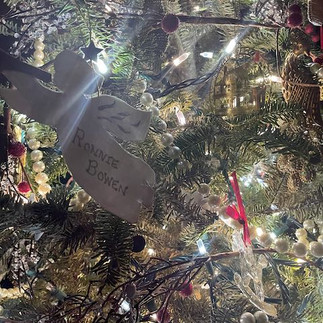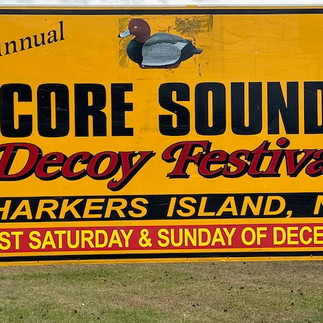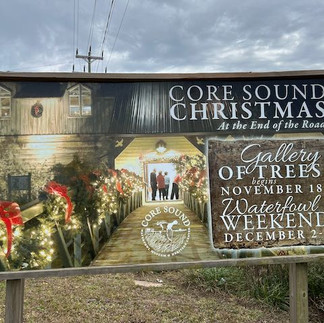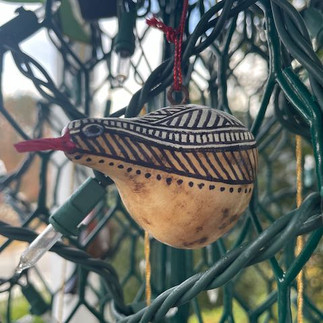Birding on a Crab Pot Christmas Tree
- Deborah Llewellyn
- Dec 5, 2022
- 9 min read

Beaufort, NC, is a wacky and wonderful place to live. A place where folks go birding. Not just wading through sea grass to watch a Great Blue Heron take flight, but also to spot carved wooden mallards with painted feathers floating in the marshes. Here in Beaufort, folks are likely to put up Christmas trees made out of repurposed crab pots. In some cases, they go birding on a crab pot Christmas tree. We do. Here's my story.
When I drag out boxes of Christmas ornaments from the attic each year, it's like boarding an airplane to the places we lived in Latin America, Asia, and Africa over twenty-five years. Somehow, a new Christmas decorating tradition in Beaufort brings our life full circle, Beaufort being a place that brings both closure and rebirth.

Our first overseas post in 1984 was in the Andean mountain town of Puno, Peru, on the banks of Lake Titicaca. We struggled to find a Christmas tree in the barren landscape and ended up plucking a spindly pine tree branch and planting it in a pot of dirt. My husband helped our 3-year-old daughter, Bronwyn, make an angel for the top out of paper plates. That was 1984. It still tops our tree. What can beat it?
When we moved overseas, we left special ornaments back home in Durham. For some reason we thought they were too precious to lose in travels abroad, so they remained packed away only to be uncovered a quarter century later. They, too, bring nostalgic memories.

In those boxes, we found pewter ornaments commemorating our wedding and the children's births, delicate hand blown glass ornaments made by a neighbor, felt ornaments made by Charles's mom, and angels from my mom. Wrapped in tissue, we found antique Santa Clauses and tin ornaments from my childhood.
Back in the 70's our friends made gifts by hand. I touch these ornaments and see the faces of our friends as I remembered them in their twenties. There's the HO HO HO ornament made by cousin Carol, miniature quilt by Elizabeth Walters and Dickens era characters made by Suzanne Yowell.
If the kids picked them up, they would mean little to them. One exception being the mistletoe holder made by our inimitable friend, Catherine Ryan, who produces porcelain and textile artifacts. The kids grew up adoring her as much as we do. Giving them opportunity to "adopt a whale" as a Christmas gift sealed the attachment. So each year her cherubic, yet devilish mistletoe holder beckons kisses and memories of our talented friends.
The decorations we collected in our years abroad were not intended as Christmas ornaments. These were small crafted items that spoke to us about the artisanship of the region. There were lama bells and tiny dolls in traditional dress from the highlands of Peru, straw and knitted animals from Ecuador, devil masks from Bolivia, carved figurines from Ghana, beaded Maasai figurines from Tanzania, miniature temple lamps from Nepal, and puppets in silken robes from Indonesia.

And then there are the ornaments we made. One year Bronwyn covered our tree in white origami stars. We made paper angels with names of family, friends and pets we loved and lost. There's a tiny felt stocking for Queenie, the white mouse that sat on Bronwyn's head while she did her homework in Bolivia. There's a Lego Santa and tree made by Chas.
In 2010 we retired from overseas work and settled back in the US, making Beaufort, NC, our home. We discovered a rich coastal fishing tradition in neighboring Harker's Island, and surrounding communities that provided an abundance of fresh oysters, shrimp, and crabs sold out of fishermen's driveways. The twelve "Down East" communities, steamed gigantic pots of seafood to share at community events. Always keen to acculturate, clam or crab chowder and oysters on the half shell became holiday fare for us as well.
These "Down East" or Core Banks communities were settled in the late 1600's by people of European descent. Initially, some early colonists lived off shore on Shackelford Banks but a series of devastating hurricanes in 1890s forced them to float their houses on barges and resettle on the mainland. These dozen communities, initially accessed only by boat, share comfort both in heritage and isolation.

"Down East" livelihood is tied to the water. Residents fish and shrimp from their boats and gather oysters and clams along the shore. It's a painter's delight to see the shrimp boats lined up in a harbor and the nets being dried and repaired on the lawn. In the winter, residents hunt water fowl and carve duck decoys. Locals were once renowned for wooden boat building, and long ago there was an industry producing oil from whales and dolphins. A bestial business for mammalian sea creatures, but justified at the time due to their availability, marketability, and community need. It was always a hardscrabble life but break-the-back times set in when wooden boats were replaced by fiberglass and the seafood industry was depleted due to reduced catch.
The keystone word for these communities is RESILIENCE. They find a way to bounce back after setbacks, and no matter what happens, they will braid events into an entertaining story told with an accent that could benefit from subtitles.
In recent years, some "Down Easterners" saw the marketability of their culture. Tourists go there to hear the one-of-a kind brogue, to attend festivals and eat at Fish Hook restaurant, go birding along marsh trails, and visit the Waterfowl Museum, which showcases museum-quality decoys made by residents, and to buy a Christmas tree made from crab pots.

For multiple generations, residents carved ducks in the winter months to float as decoys to lure wild ducks to the marshes. Some carvers became very competitive in the artistry, and there's a long history of rivalries between one family to the next over who paints the more realistic feathers on their wooden ducks and seabirds. Over the years, old decoys garnered the title of Folk Art, an old one can bring $10,000 from a New York dealer. Well, that's what Jerry Gillikin told my husband in a tone of remorse about the stack of old decoys he burned as firewood many years back. At this year's 2022 festival, my husband, Charles, spotted a decoy priced at $35,000.

The first week in December, there's a Core Sound Decoy Festival on Harker's Island. Carvers from all over the East Coast come to display, sell their work, talk some decoy lore, and hope for a big buyer "from off" to snag a winning decoy with a heavy price. The event is held in the Harker's Island Elementary School, with spillover events at the Waterfowl Museum.

The gym and library are filled with the birds of juried carvers, available for purchase. Prized antique birds are displayed and sold in the library. Classrooms house the vendors who sale wares to expert and novice carvers. The halls are decorated with posters drawn by school children and kids have the chance to paint a decoy while their parents shop.

I admire the hand-carved bird callers. One vendor showed us a block of wood with a metal strip on which he could scratch the sound of fifteen birds.

There's a competition zone in the school cafeteria where decoys are placed upside down in a pool of water and judged by how well they flip upright, float, and glow. No one questions the decisions. These judges are the masters. Decoy carving is serious business. Dr Stan Rule is judging decoys in these photos above.

We clear the calendar for this event. We are astonished at the detailed carving and painting but more than that we love to hear the carvers talk to each other. Some still speak in a brogue that's an ancient mix of Celtic/Scotch/Irish still maintained from the early settlers, who arrived from the British Isles and isolated themselves out on the Banks. While we can't afford the prize decoys, we are always delighted to pick up miniature bird ornaments from the decoy carvers who make these as souvenirs.

My husband and I first discovered Christmas trees made from crab pots at the Decoy Festival in 2010. We took to the crab-pot tree craze. We put one on our front porch, one on our screened porch and one on the deck. One year we lost one, so bought another, only to find the lost one in an attic space we forgot we had. We eventually ran out of porches (and attics). In Beaufort and Down East communities, every porch and lawn are lit with crab-pot trees.


We were curious about their origin and turned to Down East resident anthropologist, Barbara Garrity-Blake. She shared an internet link where I learned that they were invented by Harvey and Sons in Davis, NC.

Harvey and Sons Company produces crab traps, "crab pots", as the company's major product. The variable nature of the fisheries, and a desire to keep the family business growing as a legacy for his sons, prompted Nicky Harvey to look for other products. Coming from a heritage of making do with materials at hand, he played with ideas of what could be done with left-over crab pot materials. He experimented with making miniature crab pots for coastal décor, and crab pots stacked as Christmas trees. Finally, he began experimenting with triangles of the coated wire mesh, and the Core Sound Christmas tree was born.
The unique artificial tree was an immediate hit with friends and neighbors, who loved seeing the traditional material put to a new use. According to the company website, Nicky's brain just didn't quit there, he experimented until he found a way to string lights on the tree so that the product could be folded flat to 5% of their open position and then opened for display with the light strings remaining in place. U. S. Patent #6773134 was granted in 2004. In 2009, Nicky Harvey negotiated a national manufacturing and distribution agreement with Fisherman Creations, Inc., which operates just a few miles down the road from his home in Smyrna, NC. Since his patent was issued well-over 100,000 trees have been sold throughout the U.S. and overseas.
Both the Decoy Festival and the crab pot Christmas trees speak to us about scratching around in your roots to make art from family history. Something that tells your story. Legacy on display. The decoys and crab pot trees from Down East provided inspiration for us to do that.
At the Core Sound Decoy Festival and from one country to the next we seem to have amassed a good collection of bird ornaments. Some favorites are a dozen or more birds from East Africa made by two brothers who showed their wares at the Saturday market in Dar es Salaam. One brother carved and the other painted. An expatriate resident had given the brothers a Sibley's bird book of East African birds and thus a source for regional bird prototypes.

We have a dear friend in Beaufort, Stan Rule, who is a bird watcher, bird carver, and collector of Down East oral history. He is currently developing a website to share his findings and is also writing a book on the history of hunt clubs along the Southern Outer Banks. Stan carves award-winning decoys as well as song birds, and an array of elegant coastal birds.
On Saturdays he teaches kids from Down East communities to carve and decorate decoys to keep the tradition alive by making it a "cool" thing to do with friends and a cool guy. In 2021 he was the featured carver at the Festival. Quite an honor for someone from "off" (not from around here).

About twelve years ago, Stan gave us a hand carved and painted miniature decoy as a Christmas Tree ornament. It became a tradition we will not release him from. So year after year, we wait in anticipation of this year's carving. One year he made us a painted bunting in honor of that rare little bird that frequented our Marsh Street back garden. This year he gave us an adorable plover.


One of the great things about Christmas, or any holiday for that matter, is that it becomes a dream catcher for a sequence of memories, a panorama of your life, year after year. So when I think back about the holiday traditions we enjoyed overseas, often melded with traditions from the homelands of our expatriate friends, they are remembered with much fondness.
From all our holiday traditions none quite compares with the crab pot trees and Core Sound Decoy Festival as local icons of Christmas. A few years back it occurred to us that we had so many artistically carved birds that we should use them to decorate our front porch crab pot tree. We added bird ornaments we had collected from other countries along with the precious one made by Stan Rule and other carvers from Down East.

The crab pot Christmas tree, decorated with our collection of birds, symbolizes our former and current lives blended as an art form. As I've often said, the best lives are lived as art. We think of this as we stand with friends and family and go birding around the world on our crab pot Christmas tree.
Written by Deborah Llewellyn
deborah-llewellyn.com/blog
Credits
Photos
All photos were taken by the author except for the Harvey and Sons Company Sign taken from their website.

Llewellyn crab pot tree photos were taken last Christmas before our 1778 Rumley House was sold to the lovely Bill and Melissa Symonds's family in July. Currently we are renting a waterfront condo from the Symonds and our crab pot ornaments are packed up in a storage facility while we renovate our new-old 1915 Bungalow just around the corner from our old house.
Note about Down East brogue
Down East residents refer to their unique speech patterns as Hoi Toiders. The unique brogue is a combination of many early influences, especially seventeenth-century English regional dialects. The dialect's most characteristic feature is evident in the pronunciation of the phrase "high tide" as "hoi toide" in a way similar to how it is pronounced in parts of southwestern England even today. Usages such as "weren't" in the place of "wasn't" ("she weren't here") and "to" for "at" ("she's to the store now") also mark Hoi Toider speech and appear to have come from eastern England. The word "mommick," meaning to harass or bother, which was used in the time of Shakespeare, remains in the Outer Banks lexicon thanks to the Hoi Toiders. https://www.ncpedia.org/hoi-toiders
If you want to hear this brogue, check out this you tube video: https://www.ncpedia.org/hoi-toiders and https://www.youtube.com/watch?v=8Uuzr_gl4Oo
To learn more about the Down East culture, check out this website:
https://ncseagrant.ncsu.edu/coastwatch/previous-issues/2017-2/summer-2017/people-and-places-discovering-down-east-on-the-outer-banks-national-scenic-byway/
To learn more about the history of crab pot trees, check out this website: https://crabpottrees.com/about.php





















































Wow, such great information Deborah. It certainly has been a transformative journey that we have all been on together. One note: I took the picture of the Great Spangled Fritillary for my painting in Blowing Rock, NC rather than in Northern California. Just mentioning that because of the relationship to NC butterflies.
Great job as usual.
Great read! Thanks Deborah!
just lovely.
An enjoyable and educational account, Deborah. Thanks for sharing the memories and the history, especially the links for further exploration. As always, appreciate your photographer's eye and skill. Merry, merry Christmas to you and your family.